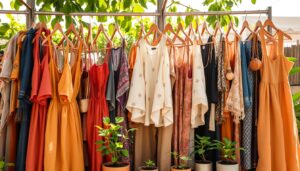As I look through my closet, I feel both pride and guilt. I’m proud of my unique clothes, but I worry about their impact on the planet. The fashion world is both stunning and harmful, causing pollution and unfair labor.
The truth is shocking: fashion is the second-biggest polluter, making up almost 10% of global carbon dioxide emissions. Yet, there’s hope in sustainable clothing brands. They focus on eco-friendly and fair practices. By choosing these brands, we improve our style and help the planet.
In this article, we’ll look at eco-friendly fashion brands leading the way to a greener future. We can shop with purpose, supporting brands that care for the environment and workers. Let’s explore how our choices can shape a brighter tomorrow.
Key Takeaways
- The fashion industry is the world’s second-largest polluter.
- Almost 10% of global carbon dioxide emissions stem from fast fashion.
- 97 million tons of waste are produced annually by the fashion industry.
- Sustainable brands often prioritize organic materials and recycling.
- Supporting brands that ensure fair labor practices promotes ethical fashion.
The Importance of Sustainable Fashion
Sustainable fashion is key to solving many problems caused by traditional fashion. The fast growth of the fashion world has harmed our environment and treated workers unfairly. It’s vital to think about these issues when we pick our clothes.
Impact on the Environment
The fashion world’s environmental damage is huge. Since the 2000s, fashion production has doubled and is set to triple by 2050. The use of polyester has grown nine times in 50 years, showing the focus on cheap, fast fashion.
The fashion industry is responsible for 10% of global greenhouse gas emissions. It also uses 93 billion metric tons of clean water every year. Choosing sustainable clothes can help solve these problems. Sustainable fashion uses less energy and water, and cuts down on carbon dioxide.
Supporting Ethical Labor Practices
There are also big issues with how workers are treated in the fashion world. Sadly, only 2% of factory workers earn a fair wage, facing bad working conditions. Supporting ethical fashion companies helps improve wages and working conditions.
Choosing sustainable fashion shows we care about the planet and people. It’s about wanting a fair and sustainable fashion industry.
| Environmental Issues | Numbers |
|---|---|
| Annual greenhouse gas emissions | 1.2 million metric tons |
| Water consumption per year | 93 billion metric tons |
| Percentage of clothing recycled | Less than 1% |
| Annual discarded clothing | 53 million metric tons |
What Defines Sustainable Clothing Brands
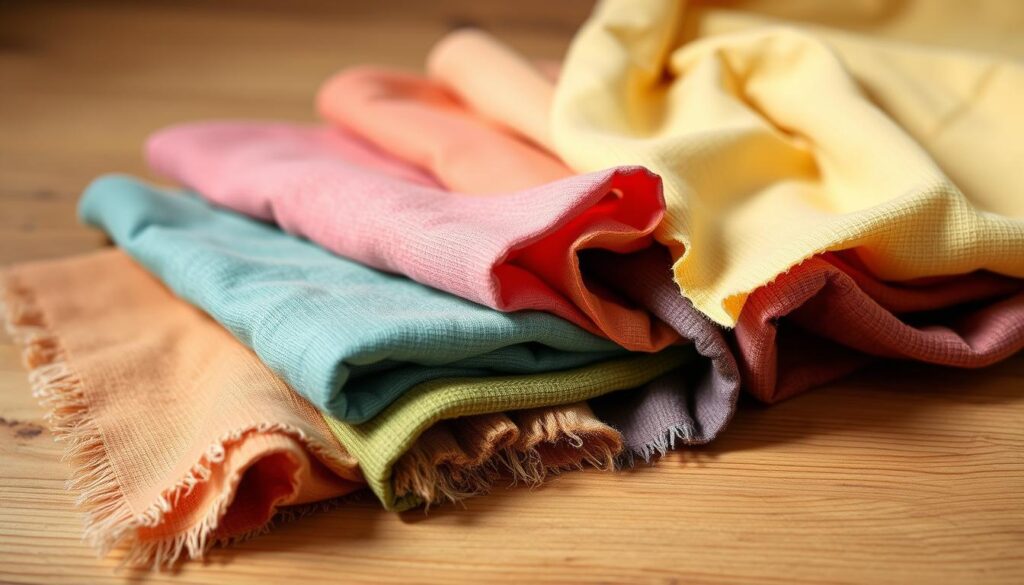
Understanding what makes sustainable clothing brands unique is key. They focus on using eco-friendly materials and ethical production methods. These steps help the environment and ensure fair treatment of workers in the fashion world.
Eco-Friendly Materials
The choice of materials is crucial for sustainable fashion. Brands use organic cotton, recycled fabrics, and natural dyes. These choices help reduce environmental harm and support healthier ecosystems.
By choosing these materials, companies help protect our planet for the future.
Ethical Production Methods
Ethical production shows a brand’s dedication to responsible manufacturing. It means safe work places, fair pay, and responsible material sourcing. Many brands also focus on recycling and upcycling to cut down waste.
This approach shows the value of caring for both the environment and workers.
My Top Picks for Sustainable Clothing Brands
I’ve found some amazing brands that focus on eco-friendly and ethical practices. They offer stylish clothes that are good for the planet and its people. These brands are at the forefront of sustainable fashion.
Proclaim
Proclaim makes gorgeous lingerie from recycled materials. They believe in inclusivity, offering sizes for everyone. This makes them a top pick for those who care about the environment and comfort.
Svala
Svala is a luxury brand known for its vegan handbags made in Los Angeles. They use eco-friendly materials, blending style with sustainability. Their commitment to ethical production is perfect for those looking for sustainable fashion.
Harvest & Mill
Harvest & Mill focuses on making high-quality clothes in the United States. They use organic materials and support local communities. Their transparent sourcing makes them a great choice for sustainable fashion.
| Brand | Specialty | Material | Production |
|---|---|---|---|
| Proclaim | Lingerie | Recycled Materials | Inclusive Sizing |
| Svala | Handbags | Vegan Materials | Handcrafted in LA |
| Harvest & Mill | Apparel | Organic Cotton | Made in the USA |
Features of the Best Sustainable Clothing Brands

The world of sustainable clothes has grown a lot. Now, we see brands that care about style, the planet, and people. They make clothes that last and are made right. This means you don’t have to buy new clothes all the time.
These brands also offer clothes for all sizes. This makes fashion for everyone, not just a few. It’s about being kind to all body types.
Durability and Timeless Design
Good sustainable clothes last a long time and look classic. Everlane shows how they make clothes with quality materials. Fair Indigo makes clothes that can last five years or more. This means you don’t need to buy new clothes as often.
Inclusivity in Sizes
Many brands now focus on being inclusive. Reformation and Ganni offer more sizes. This way, everyone can find clothes that fit and look good.
This makes fashion more welcoming. It celebrates all body types. It’s about making fashion for everyone, not just a few.
| Brand | Key Feature | Impact |
|---|---|---|
| Pact | Carbon-offset shipping | Enhances sustainable purchasing choices |
| Kotn | Fair working conditions | Impacted over 100,000 lives in Egypt |
| tentree | Tree planting initiative | Ten trees planted for every item purchased |
| Organic Basics | 1% for the Planet initiative | Supports environmental groups |
| Allbirds | Innovative materials | Uses SweetFoam® and Trino® |
How to Identify Ethical Clothing Companies
Knowing how to spot ethical clothing companies helps you make better fashion choices. Look for certifications and clear supply chain information. These signs show a brand’s dedication to being green and fair.
Certifications to Look For
When looking for ethical clothing, some certifications are key. They show a brand’s commitment to being sustainable and responsible. Here are some important labels to watch for:
- Fair Trade: Makes sure workers get fair pay and safe work conditions.
- GOTS (Global Organic Textile Standard): Focuses on organic materials and fair practices.
- OEKO-TEX: Checks if textiles are safe from harmful chemicals.
- B Corporation: Verifies a company’s high social and environmental standards.
- GoodWeave: Ensures no child labor is used in making fabrics.
Transparency in Supply Chains
It’s also important for brands to be open about their supply chains. Brands that share their production and sourcing are likely more ethical. Look for brands that give you the details on:
| Criteria | Description |
|---|---|
| Production Locations | Shows where clothes are made, so you can check labor conditions. |
| Factory Names | Helps hold brands accountable and gives insight into work places. |
| Sourcing Materials | Reveals where fabrics come from and if they’re sustainable. |
| Product Lifecycle | Details how long clothes last and how they’re disposed of, tackling waste. |
Top Eco-Friendly Fashion Brands from the US
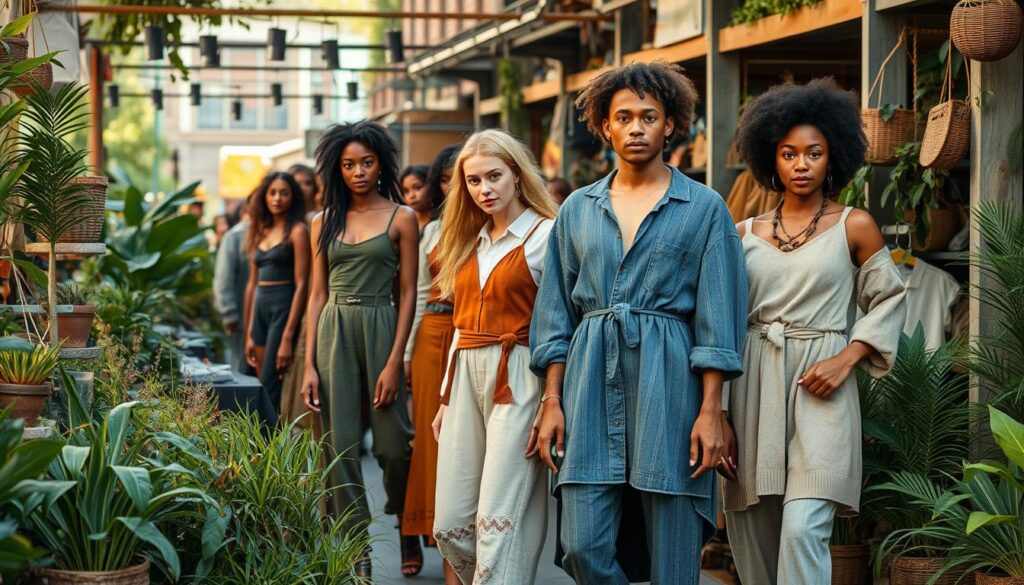
Exploring eco-friendly fashion brands shows a world of sustainable clothing companies. They focus on protecting the environment and helping people. Many brands in the US are leading the way, combining creativity with a commitment to sustainability.
Miakoda
Miakoda is based in New York City and makes organic loungewear and activewear. They offer sizes up to 4XL, making sure everyone can find something comfortable. They use natural materials, avoiding synthetics, to ensure their clothes are good for the planet and comfortable for you.
Parker Clay
Parker Clay is known for making high-quality bags and helping Ethiopian communities. They give jobs to women at risk, keeping traditional craftsmanship alive. This shows how fashion can help communities and support ethical practices.
Miakoda and Parker Clay show the variety of sustainable clothing companies in the US. They focus on the environment and help communities, proving that eco-friendly fashion and social good go hand in hand.
Innovative Sustainable Fashion Labels
Exploring the world of sustainable fashion labels shows us many inspiring brands. These companies are making a big difference. Katla and Neococo are two examples that stand out.
Katla
Katla is a leader in sustainable fashion. They focus on making clothes without wasting materials. Their designs are timeless and available for men, women, and kids.
They aim to reduce waste and use sustainable materials. Katla shows us how to make fashion more responsible.
Neococo
Neococo is all about helping women refugees through fashion. They use traditional embroidery to create unique clothes. This helps women find jobs and supports sustainable fashion.
Neococo’s mission is to make fashion both stylish and kind. They show us how fashion can help people and the planet.
| Brand | Focus Area | Key Features |
|---|---|---|
| Katla | Anti-waste manufacturing | Timeless designs, lower-impact materials |
| Neococo | Empowerment through craftsmanship | Hand embroidery, support for refugees |
Katla and Neococo show the power of creativity and ethics in fashion. They are leading the way to a more sustainable future in fashion.
Why Choose Organic Apparel?
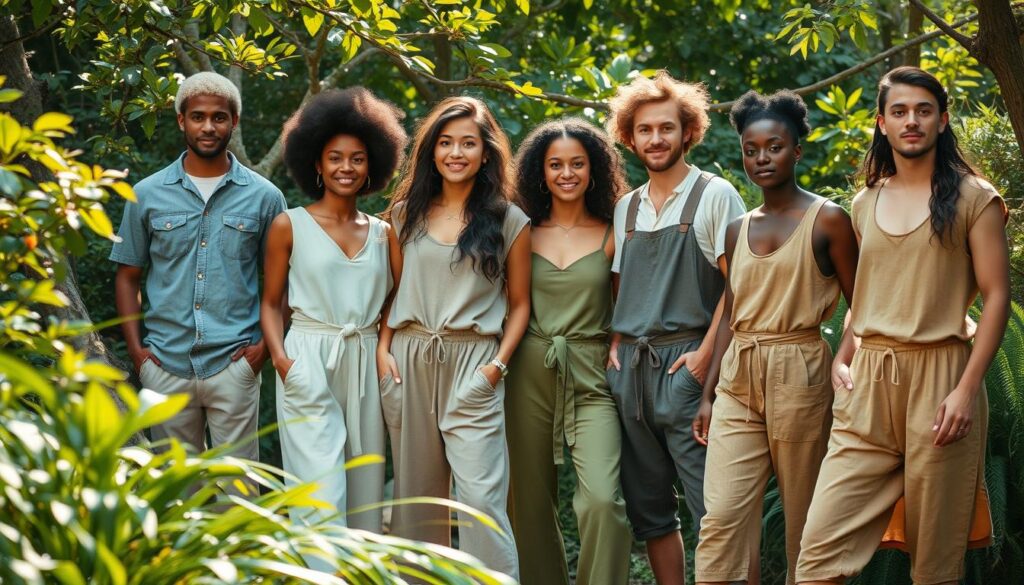
Choosing organic apparel boosts both your health and the planet’s. Organic fabrics are made without harmful chemicals. This makes your skin healthier. Plus, it helps the environment a lot.
By choosing organic clothes, you get many benefits. You also help make the world a greener place.
Health Benefits of Organic Fabrics
Wearing organic clothes is good for your health. They are made from natural fibers like cotton, hemp, and bamboo. These fabrics are gentle on your skin and don’t have harmful toxins.
Organic cotton is also softer and breathes better than synthetic fabrics. This makes it more comfortable to wear.
Environmental Advantages
Choosing organic clothes is great for the planet. Growing organic materials saves water and cuts down on pesticide use. This is important because a lot of pesticides are used for regular cotton farming.
By supporting organic fabrics, you help farmers grow crops in a better way. This encourages more sustainable farming practices.
How to Build a Sustainable Wardrobe
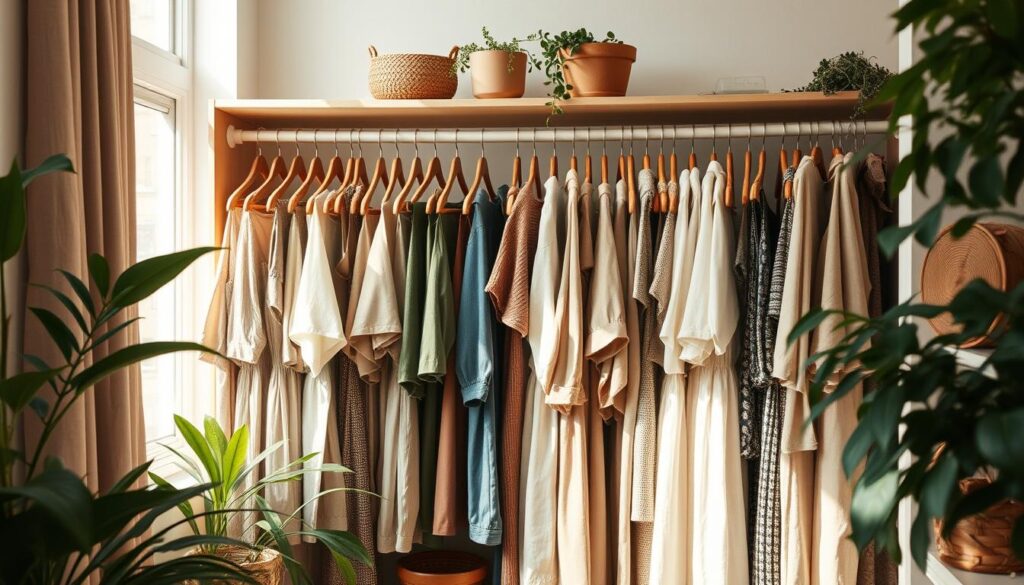
Creating a sustainable wardrobe means making choices that care for the planet and people. It’s about choosing quality over quantity. By picking durable, versatile pieces, my wardrobe stays useful and green.
Shop Secondhand
Buying secondhand clothes is a great way to cut down on waste and find unique items. In the U.S., over 300,000 tonnes of clothes are thrown away each year. Shopping at thrift stores or online at Vestiaire Collective or The RealReal helps the environment. These places support a circular economy and encourage buying less.
The #30wears campaign suggests wearing clothes at least 30 times before buying new. This makes me think more about my purchases and how often I’ll wear them.
Responsible Wardrobe Management
Being responsible with fashion goes beyond buying. It’s also about how I care for my clothes. Learning to sew or using a local tailor helps avoid throwing away damaged items. About 20% of our clothes are worn often, showing much of our wardrobe goes unused.
I try to fix small problems and refresh clothes instead of getting rid of them. Washing clothes in cold water saves a lot of energy. This reduces the environmental impact, as most of a garment’s impact comes from washing. These habits help make my wardrobe more sustainable and promote lasting fashion choices.
| Action | Impact on Sustainability |
|---|---|
| Shop secondhand clothing | Reduces waste and extends the lifecycle of garments |
| Invest in quality items | Reduces the frequency of purchases, minimizing carbon footprint |
| Mend damaged clothes | Extends garment lifespan, decreasing waste |
| Wash on colder settings | Significantly lowers energy consumption |
| Choose versatile clothing | Increases the frequency of wear, reducing the need for new purchases |
Challenges in the Sustainable Fashion Industry

The sustainable fashion world faces many obstacles. One big problem is the cost of eco-friendly clothing. Materials like organic cotton are pricier than regular ones. This makes it hard for people to choose them, even though they’re better for the planet.
Balancing Cost and Eco-Friendliness
It’s true that affordable fashion is tempting. But, sustainable fashion challenges often come from high costs. For instance, organic cotton is much more expensive than regular cotton. This affects the price of clothes a lot.
Fabrics make up a big part of a garment’s cost. So, the difference in prices can be huge. Finding a way to make sustainable clothes affordable is a big challenge.
Consumer Awareness and Education
Another big issue is getting people to know about sustainable fashion. Many don’t realize how fast fashion harms our planet. Every year, billions of tons of clothes are thrown away, causing pollution.
The fashion industry also contributes a lot to global warming. Teaching people about the effects of their shopping can help. This way, we can build a community that chooses sustainable fashion.
| Factor | Eco-Friendly Option | Conventional Option |
|---|---|---|
| Material Cost | Organic Cotton: US$500 – US$700/ton | Conventional Cotton: US$225 – US$345/ton |
| Pollution Contribution | Up to 10% of global carbon emissions | Higher percentage due to fast fashion |
| Microplastics in Oceans | Minimal from organic materials | 51 trillion particles from synthetic fibers |
| Recycling Rate | Less than 1% of clothing recycled | Predominantly non-recyclable materials |
Conclusion
The rise of sustainable fashion shows a big change in how we buy clothes. We now look for brands that care about the planet and people. By picking brands that use organic materials and green production, we help reduce waste and support fair work.
This article aimed to show why buying eco-friendly is good. Sustainable fashion is more than a trend; it’s a way of life. It teaches us to value quality over quantity, helping the environment and workers in the fashion world.
Getting involved in sustainable fashion is easy and rewarding. You can shop second-hand, try out rentals, or back local designers. Every choice we make matters. Let’s keep choosing sustainable fashion to make our planet better and secure a future for all.
FAQ
Why is sustainable fashion important?
Sustainable fashion is key because it tackles the big environmental problems of fast fashion. It cuts down on waste, pollution, and uses natural resources wisely. It also makes sure workers are treated fairly, with good pay and safe places to work.
What materials do sustainable clothing brands use?
Brands that care about the planet use materials like organic cotton, recycled fabrics, and natural dyes. These choices help cut down on waste and make our ecosystems healthier.
How can I identify ethical clothing companies?
Look for signs like Fair Trade, GOTS, and OEKO-TEX certifications. Also, check if they’re open about how they make their clothes. Brands that share their process are usually trustworthy.
Can sustainable brands be stylish?
Yes! Sustainable brands focus on making clothes that are both stylish and last long. They blend fashion with doing the right thing for the planet.
What are some of the best sustainable clothing brands?
Top brands include Proclaim for lingerie, Svala for vegan handbags, and Harvest & Mill for USA-made clothes. They show true commitment to green fashion.
How does shopping secondhand contribute to sustainability?
Buying secondhand gives old clothes a new life, cutting down on landfill waste. It also means less demand for new, fast fashion, which harms the environment.
Are organic fabrics healthier?
Yes! Organic fabrics avoid harmful chemicals, making them better for your skin. They’re also made in ways that support the planet and sustainability.
What challenges does the sustainable fashion industry face?
The industry struggles with making eco-friendly clothes affordable for everyone. It also needs to get more people to understand the harm of fast fashion.
How can I build a sustainable wardrobe?
Start by shopping mindfully and choosing secondhand options. Also, take care of your clothes to make them last longer. This helps your wardrobe stay green and stylish.
Source Links
- The 13 Best Sustainable Clothing Brands To Shop And Feel Good About
- Most Sustainable Clothing & Fashion Brands in 2024
- 30 Non Fast Fashion Brands to Leave Fast Fashion Behind
- Why Fashion Needs to Be More Sustainable
- Why Sustainable Fashion Matters: Learn the Benefits & Trends
- Sustainable fashion
- What Is Ethical and Sustainable Fashion? – Good On You
- 30 of our favourite sustainable brands to support now and love forever
- We Found Sustainable and Ethical Clothing Brands That Work for Every Budget
- 99 Sustainable Clothing Brands By Budget (2024)
- 23 Of The Best Sustainable Clothing Brands
- How To Find Sustainable Fashion Brands in 7 Easy Steps | Recycle Coach
- How do you know a clothing brand is ethical?
- Ethical Clothing Brands | Ethical Consumer
- The 59 Most Sustainable Clothing Brands from the USA
- 23 Sustainable Clothing Brands Leading the Way in 2024
- 15 Best Eco-Friendly Clothing Brands For 2024
- 15 Most Sustainable Fashion Brands (2021)
- 7 Sustainable Fashion Brands Leading The Way
- 17 Sustainable Fashion Brands Vogue Editors Love
- The Rise of Sustainable Fashion: Why Eco-Friendly Clothing is Here to Stay
- What is Sustainable Clothing? | Blog
- Nori Press
- Follow these simple steps to become more sustainable with your fashion
- 27 ways to make your wardrobe sustainable
- Sustainability Challenges in the Fashion Industry
- 5 Challenges That Sustainable Fashion Faces
- Manufacturing Platform for Apparel Industry | Fast & Sustainable – Fashinza
- The Rise of Sustainable Fashion Trends
- What is Sustainable Fashion: Definition & Examples %%page%% %%sep%% %%sitename%%
- What is Sustainable Fashion? Is It Expensive? and How to Achieve it?


